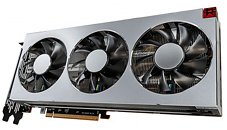Friday, February 8th 2019

No AMD Radeon "Navi" Before October: Report
AMD "Navi" is the company's next-generation graphics architecture succeeding "Vega" and will leverage the 7 nm silicon fabrication process. It was originally slated to launch mid-2019, with probable unveiling on the sidelines of Computex (early-June). Cowcotland reports that AMD has delayed its plans to launch "Navi" all the way to October (Q4-2019). The delay probably has something to do with AMD's 7 nm foundry allocation for the year.
AMD is now fully reliant on TSMC to execute its 7 nm product roadmap, which includes its entire 2nd generation EPYC and 3rd generation Ryzen processors based on the "Zen 2" architecture, and to a smaller extent, GPUs based on its 2nd generation "Vega" architecture, such as the recently launched Radeon VII. We expect the first "Navi" discrete GPU to be a lean, fast-moving product that succeeds "Polaris 30." In addition to 7 nm, it could incorporate faster SIMD units, higher clock-speeds, and a relatively cost-effective memory solution, such as GDDR6.
Source:
Cowcotland
AMD is now fully reliant on TSMC to execute its 7 nm product roadmap, which includes its entire 2nd generation EPYC and 3rd generation Ryzen processors based on the "Zen 2" architecture, and to a smaller extent, GPUs based on its 2nd generation "Vega" architecture, such as the recently launched Radeon VII. We expect the first "Navi" discrete GPU to be a lean, fast-moving product that succeeds "Polaris 30." In addition to 7 nm, it could incorporate faster SIMD units, higher clock-speeds, and a relatively cost-effective memory solution, such as GDDR6.

135 Comments on No AMD Radeon "Navi" Before October: Report
Also, GCN has been evolving with each generation. Vega, for example, significantly changed the compute units (longer pipes allowing for higher clocks).
GCN is still a jack-of-all-trades and master-of-none architecture. I'm not convinced AMD wants to fork Radeon architectures from Instinct and Pro cards. They effectively need two engineering staffs to do that.
What GCN is really lacking is tiled rasterization. If Navi brings that, it will more align it with GeForce performance in gaming.
1) AMD said they're working on RTRT implementation, so it doesn't make much sense to release new cards without it. Maybe they need more time for polishing their solution.
2) 7nm is rubbish at the moment, so they'll allocate all of it to the bin and wait until TSMC improves this tech.
AMD creats an architecture, then AMD's partner decide what to include or not. AMD designed polaris then Microsoft decided what feature to include in their custom SoC.
And if we go by your logic, then it can be said that Nvidia designed Kepler and up for smartphone and Switch.
Some looked at that and concluded they want to sneak Navi in, but I was pretty sure it meant Navi is still far from launch.
Still, it matters little if Navi launches two-three months early or late. What matters is if it can take the fight to Nvidia. So far, it looks like it can't. To make things worse, in Q4'19 means it will go up against 7nm Turing (or whatever it will be called).
This one is exclusive to Polaris and newer:
Everything Xbox One X can do Polaris desktop cards can do too. It's really a chicken or the egg argument. AMD puts engineering resources into features both types of customers like.Ampere? Unless Ampere is replacing Volta.
Nvidia sells a tensor accelerator and it can work in tandem with a traditional GPGPU device.
Also, how do you know they haven't started earlier? They most likely knew a lot about Nvidia's RTRT hardware all along. They may have been surprised by performance, so their solution needed more work to be competitive.By principle you can run RTRT (DXR) even on a x86 CPU. Actually CPUs are quite competitive in this (ray tracing is a painfully sequential mathematical problem).
Using normal GPGPU you may be able to run a 500x500px 30fps render (the "preview" window in 3D software). Purpose built hardware is orders of magnitude faster.
Luckily for us Nvidia took a hit based on Turing sales, so hopefully we won't see that move ever again. But this is way OT.
I wouldn't be surprised if Microsoft is insisting on DXR for their next Xbox which might be Arcturus architecture (follows Navi).
devblogs.nvidia.com/vulkan-raytracing/
That said, I have no idea whether Navi will have RTRT capabilities or not.
Also, TSMC has run into prod issues before and had to scrape their entire 22nm node. I imagine 7nm is harder than that, even with the lessons learned, so yeah, prod issues combined with GloFo's downshifting on 7nm is what probably cause the delay.Nvidia has been opening bottles ever since Vega (if not earlier). They may have run out of bottles to open by now.
2017 Annual Financial Reports
Intel 71 billion dollars revenue and 21 billion dollars profit
Nvidia 9.7 billion dollars revenue and 3 billion dollars profit
AMD 5.3 billion dollars revenue and 43 million dollars profit (this includes both CPU and GPU businesses)
The problem AMD has is pretty obvious and frankly it's amazing that they were even able to bring Ryzen to market as it is.
DXR was introduced for GCN 2 and up and a feature of AMD.
And new GPU architecture AMD must support new video codec and thats why every polaris and up has HEVC support.
again.. why is this topic not tagged as a rumor???
I hear it constantly that AMD is lazy or incompetent and that used to be true but not since Lisa Su became CEO. They dug themselves into this financial pit by being that way in the past but once again to fully understand why they lag behind you have to look at their present financials. They are a very, very small company compared to Intel and they are small compared to Nvidia as well.